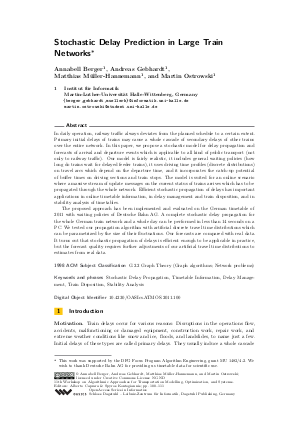Stochastic Delay Prediction in Large Train Networks
Authors Annabell Berger, Andreas Gebhardt, Matthias Müller-Hannemann, Martin Ostrowski
-
Part of:
Volume:
11th Workshop on Algorithmic Approaches for Transportation Modelling, Optimization, and Systems (ATMOS 2011)
Part of: Series: Open Access Series in Informatics (OASIcs)
Part of: Conference: Symposium on Algorithmic Approaches for Transportation Modelling, Optimization, and Systems (ATMOS) - License:
 Creative Commons Attribution-NonCommercial-NoDerivs 3.0 Unported license
Creative Commons Attribution-NonCommercial-NoDerivs 3.0 Unported license
- Publication Date: 2011-09-19
File

PDF
OASIcs.ATMOS.2011.100.pdf
- Filesize: 0.6 MB
- 12 pages
Document Identifiers
Subject Classification
Keywords
- stochastic delay propagation
- timetable information
- delay management
- train disposition
- stability analysis
Metrics
- Access Statistics
-
Total Accesses (updated on a weekly basis)
0Document
0Metadata
Abstract
In daily operation, railway traffic always deviates from the planned schedule to a certain extent. Primary initial delays of trains may cause a whole cascade of secondary delays of other trains over the entire network. In this paper, we propose a stochastic model for delay propagation and forecasts of arrival and departure events which is applicable to all kind of public transport (not only to railway traffic). Our model is fairly realistic, it includes general waiting policies (how long do trains wait for delayed feeder trains), it uses driving time profiles (discrete distributions) on travel arcs which depend on the departure time, and it incorporates the catch-up potential of buffer times on driving sections and train stops. The model is suited for an online scenario where a massive stream of update messages on the current status of trains arrives which has to be propagated through the whole network. Efficient stochastic propagation of delays has important applications in online timetable information, in delay management and train disposition, and in stability analysis of timetables. The proposed approach has been implemented and evaluated on the German timetable of 2011 with waiting policies of Deutsche Bahn AG. A complete stochastic delay propagation for the whole German train network and a whole day can be performed in less than 14 seconds on a PC. We tested our propagation algorithm with artificial discrete travel time distributions which can be parametrized by the size of their fluctuations. Our forecasts are compared with real data. It turns out that stochastic propagation of delays is efficient enough to be applicable in practice, but the forecast quality requires further adjustments of our artificial travel time distributions to estimates from real data.
Cite As Get BibTex
Annabell Berger, Andreas Gebhardt, Matthias Müller-Hannemann, and Martin Ostrowski. Stochastic Delay Prediction in Large Train Networks. In 11th Workshop on Algorithmic Approaches for Transportation Modelling, Optimization, and Systems. Open Access Series in Informatics (OASIcs), Volume 20, pp. 100-111, Schloss Dagstuhl – Leibniz-Zentrum für Informatik (2011)
https://doi.org/10.4230/OASIcs.ATMOS.2011.100
BibTex
@InProceedings{berger_et_al:OASIcs.ATMOS.2011.100,
author = {Berger, Annabell and Gebhardt, Andreas and M\"{u}ller-Hannemann, Matthias and Ostrowski, Martin},
title = {{Stochastic Delay Prediction in Large Train Networks}},
booktitle = {11th Workshop on Algorithmic Approaches for Transportation Modelling, Optimization, and Systems},
pages = {100--111},
series = {Open Access Series in Informatics (OASIcs)},
ISBN = {978-3-939897-33-0},
ISSN = {2190-6807},
year = {2011},
volume = {20},
editor = {Caprara, Alberto and Kontogiannis, Spyros},
publisher = {Schloss Dagstuhl -- Leibniz-Zentrum f{\"u}r Informatik},
address = {Dagstuhl, Germany},
URL = {https://drops.dagstuhl.de/entities/document/10.4230/OASIcs.ATMOS.2011.100},
URN = {urn:nbn:de:0030-drops-32705},
doi = {10.4230/OASIcs.ATMOS.2011.100},
annote = {Keywords: stochastic delay propagation, timetable information, delay management, train disposition, stability analysis}
}
